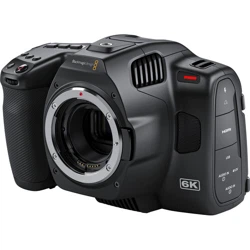Loading ...
Loading ...
Loading ...

To change the sensor frame rate, tap the arrows next to the sensor frame rate indicator in the
lower left of your touchscreen. You can also drag the slider left or right to increase or decrease
the frame rate. Once you release the slider, the sensor frame rate will be selected. Above the
slider, you can tap on a common off speed frame rate. These are based on your current project
frame rate.
You can create dynamic and interesting speed effects in your clips by varying the sensor frame
rate. Setting the sensor frame rate higher than your project frame rate willcreate slow motion
during playback. For example, shooting with a 60 FPS sensor frame rate and playing back at a
24 FPS project frame rate creates slow motion at 40% of the real speed of the action.
Alternatively, the lower your sensor frame rate, the faster your clips will appear. The principle is
similar to overcranking and undercranking a film camera. Overcranking speeds up the sensor
frame rate so you can stretch out moments in time during playback to enhance emotion.
Undercranking slows down the sensor frame rate so you can increase the speed of action in
fast moving scenes. The creative possibilities are endless and entirely up to you!
For information on the maximum frame rates available for each recording format and codec,
refer to the table in the ‘recording’ section of this manual.
NOTE When ‘off speed frame rate’ is selected the audio and video are no longer
synced. This is true even if you set the same project and sensor frame rate. For this
reason, avoid selecting ‘off speed frame rate’ if you want to guarantee audio syncing.
Shutter
The ’shutter’ indicator displays your shutter angle or shutter speed. By tapping this indicator,
you can manually change your camera’s shutter values or configure shutter priority auto
exposure modes. The shutter measurement setting can be used to select whether to display
shutter information as ‘shutter angle’ or ‘shutter speed’. See the ‘setup settings’ section in this
manual for more information.
Tap the shutter indicator to access shutter settings
Shutter angle or shutter speed defines the level of motion blur in your video, and can be used
to compensate for varying light conditions. 180 degrees is the optimum shutter angle for
capturing satisfying motion blur in most conditions, with the equivalent being a shutter speed of
1/50th of a second. However as lighting conditions change, or the amount of movement in your
scene increases, you may decide to adjust accordingly.
For example, 360 degrees is considered ‘wide open’ and allows maximum light onto the sensor.
This is useful for low light conditions with subtle movement in your scene. Alternatively,
ifshooting subjects with a lot of movement, a narrow shutter angle like 90degrees will provide
minimal motion blur for sharper, crisper images. The equivalent shutter speeds compared to
shutter angle depends on the frame rate you are using.
For example, if you are shooting at 25frames per second, then 360 degrees will equate to
1/25th, and 90 degrees will equate to 1/100th of a second.
48Touchscreen Controls
Loading ...
Loading ...
Loading ...
